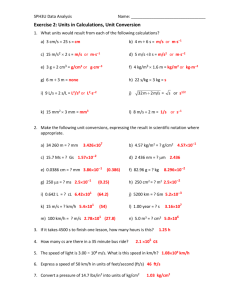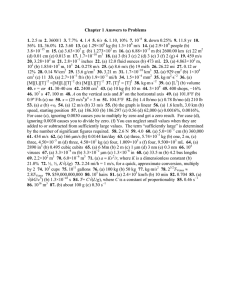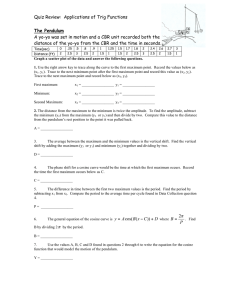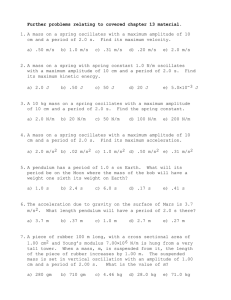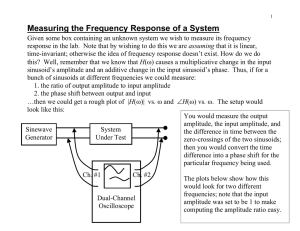Chapter 10 Answers to Problems 1. 10.
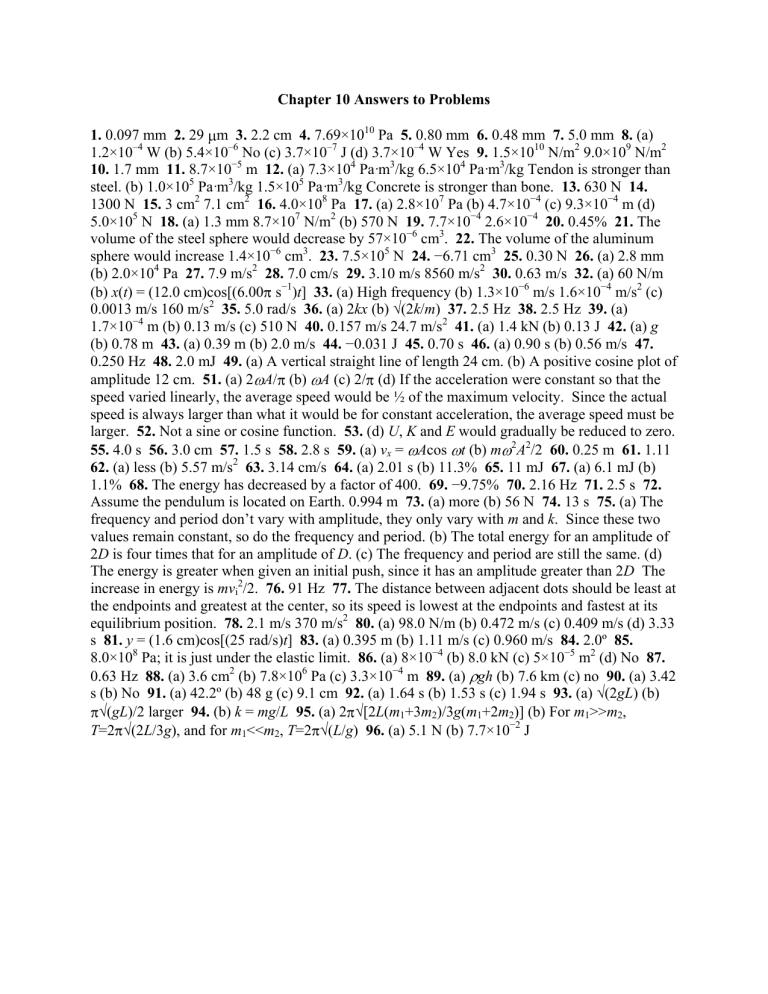
Chapter 10 Answers to Problems
1.
0.097 mm
1.2×10
–4
2.
29 m
W (b) 5.4×10
–6
3.
2.2 cm 4.
7.69×10
No (c) 3.7×10
–7
10
Pa 5.
0.80 mm 6.
0.48 mm 7.
5.0 mm 8.
(a)
J (d) 3.7×10
–4
W Yes 9.
1.5×10
10
N/m
2
9.0×10
9
N/m
2
10.
1.7 mm 11.
8.7×10
−5
m 12.
(a) 7.3×10
4
Pa·m
3
/kg 6.5×10
4
Pa·m
3
/kg Tendon is stronger than steel. (b) 1.0×10
5
Pa·m
3
/kg 1.5×10
5
Pa·m
3
1300 N 15.
3 cm
2
7.1 cm
2
16.
4.0×10
8
/kg Concrete is stronger than bone. 13.
630 N 14.
Pa 17.
(a) 2.8×10
7
Pa (b) 4.7×10
−4
(c) 9.3×10
−4
m (d)
5.0×10
5
N 18.
(a) 1.3 mm 8.7×10
7
N/m
2
(b) 570 N 19.
7.7×10
−4
2.6×10
−4
20.
0.45% 21.
The volume of the steel sphere would decrease by 57×10
−6
cm
3
. 22.
The volume of the aluminum sphere would increase 1.4×10
(b) 2.0×10
4
Pa 27.
7.9 m/s
−6
cm
2
28.
7.0 cm/s 29.
3.10 m/s 8560 m/s
(b) x ( t ) = (12.0 cm)cos[(6.00 s
−1
) t
3
.
]
23.
33.
7.5×10
5
N 24.
−6.71 cm
3
25.
0.30 N 26.
(a) 2.8 mm
2
30.
0.63 m/s 32.
(a) 60 N/m
(a) High frequency (b) 1.3×10
−6
m/s 1.6×10
−4
m/s
2
(c)
0.0013 m/s 160 m/s
2
35.
5.0 rad/s 36.
(a) 2 kx (b) √(2 k / m ) 37.
2.5 Hz 38.
2.5 Hz 39.
(a)
1.7×10
−4
m (b) 0.13 m/s (c) 510 N 40.
0.157 m/s 24.7 m/s
2
41.
(a) 1.4 kN (b) 0.13 J 42.
(a) g
(b) 0.78 m 43.
(a) 0.39 m (b) 2.0 m/s 44.
−0.031 J 45.
0.70 s 46.
(a) 0.90 s (b) 0.56 m/s 47.
0.250 Hz 48.
2.0 mJ 49.
(a) A vertical straight line of length 24 cm. (b) A positive cosine plot of amplitude 12 cm. 51.
(a) 2 A / (b) A (c) 2/ (d) If the acceleration were constant so that the speed varied linearly, the average speed would be ½ of the maximum velocity. Since the actual speed is always larger than what it would be for constant acceleration, the average speed must be larger. 52.
Not a sine or cosine function. 53.
(d) U , K and E would gradually be reduced to zero.
55.
4.0 s 56.
3.0 cm 57.
1.5 s 58.
2.8 s 59.
(a) v x
= A cos t (b) m
62.
(a) less (b) 5.57 m/s
2
63.
3.14 cm/s 64.
(a) 2.01 s (b) 11.3% 65.
2
A
2
/2 60.
0.25 m 61.
1.11
11 mJ 67.
(a) 6.1 mJ (b)
1.1% 68.
The energy has decreased by a factor of 400. 69.
−9.75% 70.
2.16 Hz 71.
2.5 s 72.
Assume the pendulum is located on Earth. 0.994 m 73.
(a) more (b) 56 N 74.
13 s 75.
(a) The frequency and period don’t vary with amplitude, they only vary with m and k . Since these two values remain constant, so do the frequency and period. (b) The total energy for an amplitude of
2 D is four times that for an amplitude of D . (c) The frequency and period are still the same. (d)
The energy is greater when given an initial push, since it has an amplitude greater than 2 D The increase in energy is mv i
2
/2. 76.
91 Hz 77.
The distance between adjacent dots should be least at the endpoints and greatest at the center, so its speed is lowest at the endpoints and fastest at its equilibrium position. 78.
2.1 m/s 370 m/s
2
80.
(a) 98.0 N/m (b) 0.472 m/s (c) 0.409 m/s (d) 3.33 s 81.
y = (1.6 cm)cos[(25 rad/s) t ] 83.
(a) 0.395 m (b) 1.11 m/s (c) 0.960 m/s 84.
2.0º 85.
8.0×10
8
Pa; it is just under the elastic limit. 86.
(a) 8×10
0.63 Hz 88.
(a) 3.6 cm
2
(b) 7.8×10
6
−4
(b) 8.0 kN (c) 5×10
−5
m
2
(d) No 87.
Pa (c) 3.3×10
−4
m 89.
(a) gh (b) 7.6 km (c) no 90.
(a) 3.42 s (b) No 91.
(a) 42.2º (b) 48 g (c) 9.1 cm 92.
(a) 1.64 s (b) 1.53 s (c) 1.94 s 93.
(a) √(2 gL ) (b)
√( gL )/2 larger 94.
(b) k = mg / L 95.
(a) 2 √[2 L ( m
1
+3 m
2
)/3 g ( m
1
+2 m
2
)] (b) For m
1
>> m
2
,
T =2 √(2 L /3 g ), and for m
1
<< m
2
, T =2 √( L / g ) 96.
(a) 5.1 N (b) 7.7×10
−2
J
